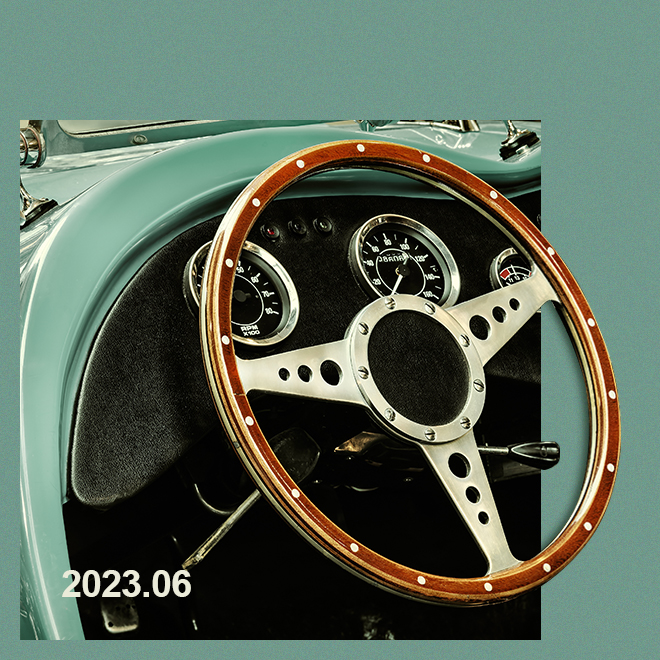-
CMF(Color, Material, Finish) Newsletter. 2023.10-1

As Korean cultural and artistic content gains global popularity, there's a burgeoning movement in the industrial and design sectors to apply designs and materials rooted in Korea's unique spirit and culture to various objects. Hïda has set the keyword for the October CMF (Color, Material, Finish) newsletter as 'K(Korea)-CMF,' introducing recent examples related to materials of CMF value within traditional Korean culture. In Part 1, we'll discuss attributes and analogous cases of Giwa (roof tiles), Dancheong (decorative multicolored patterns), brass, and Hanji.

ⓒgettyimagesbank
Traditional Korean houses, 'Hanok,' are categorized mainly into residential, palatial, and religious facilities. Residential Hanoks manifest diverse shapes according to social status or rank. A significant attribute of Hanok is its foundational structure, predominantly crafted from timber. We will delve into the CMF characteristics found in Hanok, especially Giwa and Dancheong.
Giwa (Roof Tile)
Korea, Crafting the New Black



ⓒgettyimagesbank
'Giwa,' traditionally used for roofing in China, Japan, and Korea, is an architectural material. Molded from kiln-fired clay, Giwa is a barrier to rain and an anti-corrosion solution for roofs while enhancing a building’s aesthetic. Korean Giwa, due to the nature of its clay and manufacturing processes, showcases diverse black hues, including blue-black and brown-black. Additionally, Cheong-Giwa undergoes a two-time firing process with a blue-hued glaze.

ⓒSAMSUNG

ⓒVITRA·CHANEL·ROLEX
Samsung's mobile phone model, the Blue-Black D500, released in 2005, became a sensation, selling over 10 million units due to its functionality, design, and luxurious blue-black shade that captivatingly blended blues and violets, showcasing Korean color aesthetics. Numerous brands, including Verner Panton's Panton Chair, Chanel's perfume bottles, and Rolex's watches, perpetuate the exploration of the 'new black.' Seek inspiration through the black Hanok roof tiles, embodying Korean color sensibilities.

ⓒhïda
hïda, in collaboration with Korea's Samhwa Paint Industrial, has developed 'K-Black' - a new black paint lineup that subtly reveals various hues depending on the viewing angle. This eco-friendly paint, enriched with plant-derived oils, requires a multi-layer coating and incorporates Samhwa Paint Industrial’s proprietary colorants and unique pigment blending expertise. It's currently under mass-production research at INTOPS, hïda’s parent company.
hïda's CMF Selection
Dancheong
Korean Traditional Patterns Carved into Lamborghini


ⓒgettyimagesbank
Historically, the wooden Hanoks were adorned with multicolored patterns called 'Dancheong,' serving functional and aesthetic purposes. The vibrancy and brilliance of Korean Dancheong, discernible especially in religious establishments and palaces, stand as a testament to the outstanding aesthetic intuition of our ancestors.

ⓒLIE SANGBONG
Even today, Dancheong remains a crucial motif in Korean design. Renowned Korean fashion designer Lee Sang-bong is famous for incorporating Korean motifs like Hangul or Dancheong into his work. Here, we introduce the unique colors of Dancheong, rendered into Pantone codes.

ⓒpantone

ⓒLamborghini·Starbucks Korea
In 2021, Italian supercar brand Lamborghini unveiled a limited edition Aventador-S crafted exclusively for Korean clientele, inspired by traditional patterns and colors evident in Dancheong. Additionally, in commemorating the Korean Liberation Day on August 15th, Starbucks Korea launched tumblers, coasters, and jewelry boxes developed in collaboration with mother-of-pearl artisans. Notably, the inlay patterns on the boxes and the overall dark green hue of the products drew inspiration from the CMF essence of Dancheong.
Brass
The Rediscovery of Aged Brass, K-gold


ⓒgettyimagesbank

ⓒBangjja Organic Museum
‘Brass,’ a fusion composed roughly at a ratio of 7:3 between copper and tin, has a deep-rooted history in Korea. Especially during the Joseon Dynasty (1392-1910), many brass products, from tableware and musical instruments to everyday items, were crafted. The Bangjja Bronzeware Museum in Daegu, Korea, showcases a myriad of these brass artifacts, each exemplifying the intrinsic and beautiful CMF value of brass.
hïda's CMF Selection

ⓒhïda
The paint, 'K-Gold,' co-developed by hïda and Korea's Samhwa Paint Industrial, is the culmination of extensive research into the authentic hues of Korean brass. Like K-Black, this eco-friendly paint, enhanced with plant-extracted oils, demands multi-layered application and incorporates Samhwa Paint's proprietary colorant and unique pigment blending expertise. Currently, INTOPS, the parent company of hïda, is immersed in the production research of this innovation.
hïda's CMF Selection
Hanji
A Millennia-old Natural Material, Hanji


ⓒgettyimagesbank
The art of producing Hanji, Korea’s traditional paper, flourished around the 7th and 8th centuries. Crafted by pounding the bark of the mulberry tree, Hanji stands out with its pristine and silky texture. Celebrated in Korea for its functional and aesthetic excellence, Hanji has adorned house doors, books, artwork, and fans. Through the lens of CMF design, Hanji's distinct patterns and colors hold an essence worthy of the epithet 'K-CMF.' Embracing this nature-aligned CMF sentiment is recommended for integration into design projects.
hïda's CMF Selection

ⓒDUPONT
Global materials brand DuPont’s TYVEK is an innovative fabric birthed from high-density polyethylene (HDPE) fibers conceived by DuPont. Despite bearing a paper-like exterior, it boasts superior strength and lightness than paper, accompanied by remarkable water resistance. Intrinsically a petrochemical product, TYVEK classifies it as plastic. Hence, it is 100% recyclable. Upon incineration, it harmlessly decomposes into water and carbon dioxide, and its landfill footprint remains free from chemical seepage, marking its stature as a truly eco-friendly material.

ⓒHYUNDAI
An illustrative example of the synergy between Hanji's aura and TYVEK is witnessed in the interiors of Hyundai's electric vehicle, IONIQ 5. The predominantly light monochromatic interior concept aligns seamlessly with the eco-friendly CMF elements of the electric car. The door design, particularly rendered using TYVEK, stands out with a compelling appeal.

ⓒhïda
hïda, recognizing the functional and aesthetic merits of Hanji, has been assiduously working on research and mass-production initiatives to transpose these Hanji attributes into industrial CMF, birthing Hanji Leather. Although it doesn't replicate the exact patterns or textures of traditional Hanji, this material holds significance as it is fashioned by layering eco-friendly plant-based substrates.

 Save
Save









